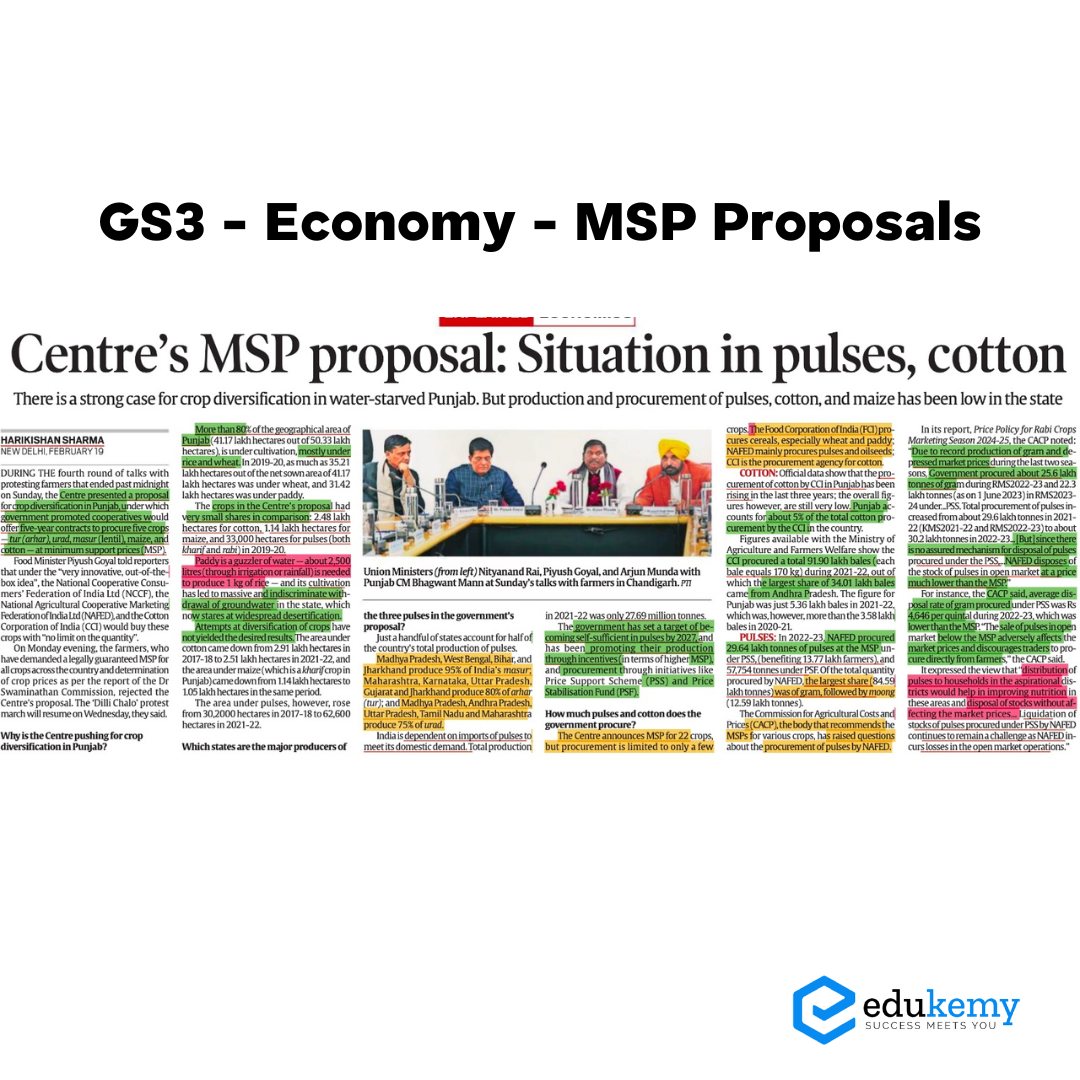Friday, 23rd February 2024
Daily News Paper Snippets - 23rd February 2024
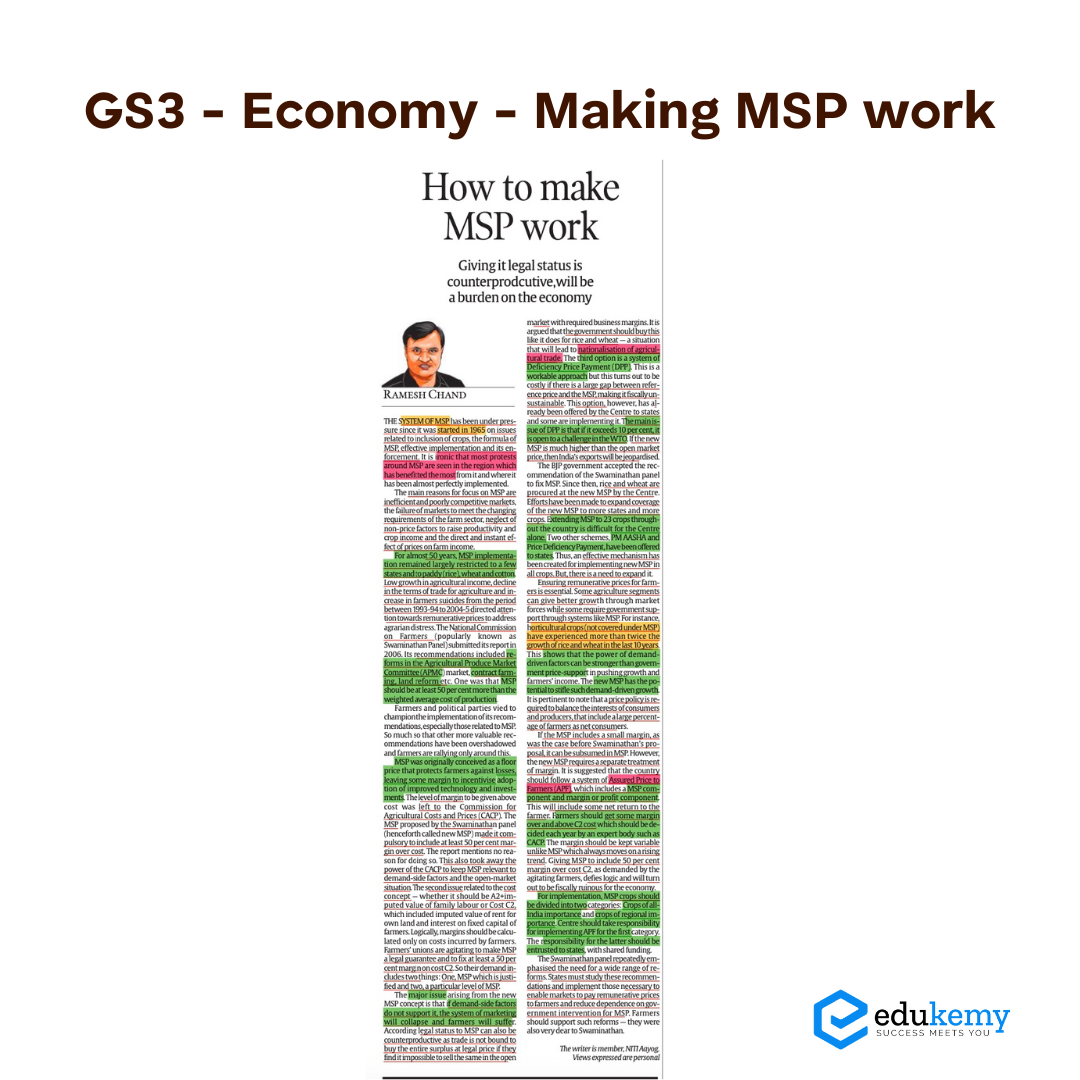
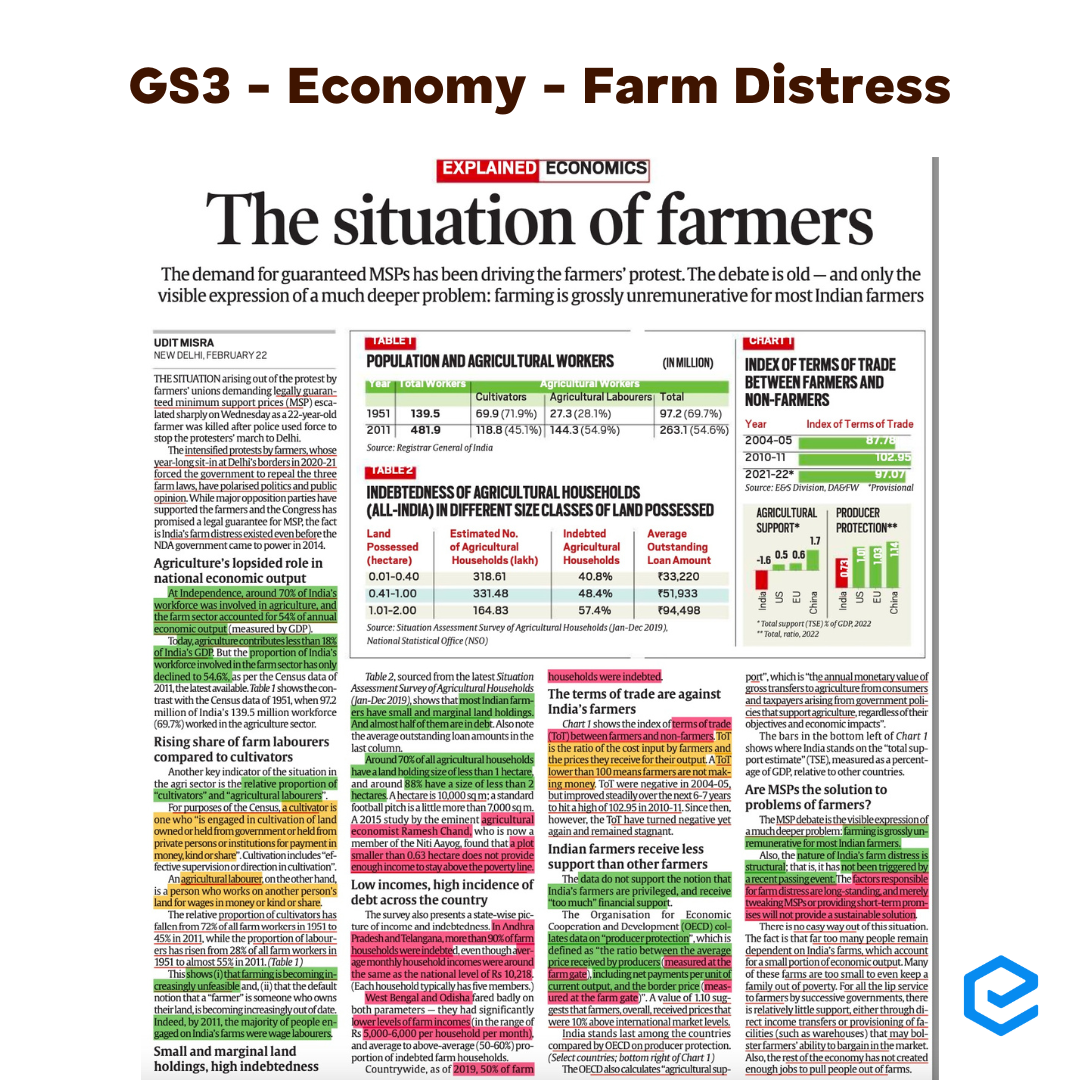
Concerns Raised on Plastic Waste Pollution
In News: A parliamentary committee expressed apprehensions regarding the inadequate management of plastic waste in the nation, referencing findings from a report by the Comptroller and Auditor General (CAG).
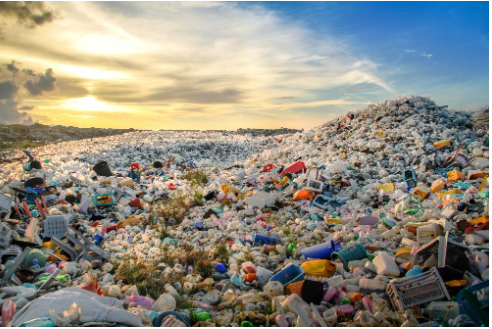
PAC Report Findings on Plastic Pollution
- Acknowledgment of Ministry's Efforts
- Recognizes the Ministry's initiatives on plastic waste since May 2021.
- Calls for more effective measures against plastic pollution hazards.
- Increasing Plastic Waste Generation
- Plastic waste generation surged from 15.9 lakh tonnes per annum in 2015-16 to 41.2 lakh TPA in 2020-21.
- Unutilized Plastic Waste and Environmental Impact
- 50% (34.7 lakh TPA) of total plastic waste in 2019-20 remained unused.
- Resulted in air, water, and soil pollution, impacting human health.
- Data Gap and Inconsistencies
- Identifies significant data gaps.
- Notes inconsistencies in data shared by State Pollution Control Boards (SPCBs) and Urban Local Bodies (ULBs).
- Importance of Finding Alternatives to Plastic
- Emphasizes the need for a cost-effective alternative to plastic for effective elimination.
Measures to Curb Plastic Pollution
- Global Level Initiatives
- 124 countries sign resolution for a binding agreement to end plastic pollution.
- United Nations Economic and Social Commission's "Closing the loop" project.
- Global Tourism Plastics initiative committing to reduce plastic pollution by 2025.
- EU Directive on Single-Use Plastics effective since July 2021.
- Indian Government's Measures
- Ban on hard-to-collect/recycle Single-Use Plastics (SUP).
- Plastic Waste Management (Amendment) Rules, 2022, introducing Extended Producer Responsibility (EPR) guidelines.
- Emphasis on local bodies' responsibility for plastic waste management.
- Initiatives like National Dashboard, India Plastics Pact, Project REPLAN, and National Green Tribunal (NGT).
PAC Report Recommendations
- Reliable Data Assessment
- Urges a reliable assessment of plastic waste generation.
- Mandatory Reporting on National Dashboard
- Recommends mandatory online reporting of data on the national dashboard.
- Urgent and Effective Enforcement Measures
- Calls for immediate steps, awareness campaigns, R&D funding for alternatives, accountability of implementing agencies, and promoting recycled plastic content.
- Vigilance over Industrial Practices
- Stresses close monitoring of industries to ensure genuine efforts in collection and recycling.
- Bottom-Up Approach
- Advocates a bottom-up approach with a plastic waste recycling unit in every block.
- Encouraging Industry Participation
- Recommends incentivizing industries to set up local recycling units and collaborate with waste pickers for effective waste management.
|
UPSC Previous Year Questions Prelims (2019) Q. In India, ‘extend producer responsibility’ was introduced as an important feature in which of the following? (a) The Bio-medical Waste (Management and Handling) Rules, 1998 Ans: (c) Prelims (2018) Q.2 How is the National Green Tribunal (NGT) different from the Central Pollution Control Board (CPCB)?
Which of the statements given above is/are correct? (a) 1 only Ans: (b) |
Source: TOI
Unauthorised online lending apps high on FSDC scanner
In News: During the 28th meeting of the Financial Stability and Development Council (FSDC), the Finance Minister directed financial sector regulators to implement additional measures to prevent the proliferation of unauthorized lending facilitated by online applications.
Financial Stability and Development Council (FSDC)
- About
- An apex-level body established by the Government of India in 2010.
- Operates under the Financial Stability Division of the Department of Economic Affairs, Ministry of Finance.
- Background
- Formed in response to the global financial crisis of 2008.
- Suggested by the Raghuram Rajan Committee in 2008 to address macro-prudential and financial irregularities in India's financial system.
- Composition
- Chairperson: Union Finance Minister of India.
- Members: Various key officials, including the Governor of the Reserve Bank of India (RBI) and heads of regulatory bodies.
- Responsibilities
- Concerns raised about potential jeopardy to the autonomy of sectoral regulators, especially when led by the Union Finance Minister.
- Emphasis on safeguarding the autonomy of sectoral regulators and creating functional guidelines to address this issue.
What is Digital Lending?
- Definition
- The process of availing credit online using technology in various stages, including customer acquisition, credit assessment, loan approval, disbursement, and recovery.
- Need for Regulation
- India has witnessed a surge in illegal digital lending apps, especially targeting low-income individuals.
- These apps, offering small loans with high-interest rates, have led to issues such as harassment by recovery agents and breaches of privacy.
Unauthorised online lending apps high on FSDC scanner
- The Financial Stability and Development Council (FSDC) discussed concerns about unauthorised online lending apps.
- The council, chaired by Finance Minister Nirmala Sitharaman, urged regulators to take measures to curb the spread of unauthorised lending through online apps.
- Emphasized maintaining vigilance and proactively detecting emerging financial stability risks in the domestic and global macro-financial situation.
Source: TH
NeSDA Way Forward Report 2023
In News: The 'Annual NeSDA Way Forward Report 2023' by DARPG reveals Jammu & Kashmir's dominance with 1,117 e-services on the NeSDA Way Forward Dashboard.
Key Highlights of the NeSDA Way Forward Report 2023
- Total Mapped E-Services
- As of December 2023, the NeSDA Way Forward Dashboard reflects 16,487 mapped e-Services, showcasing extensive digital service delivery.
- Jammu & Kashmir leads with 1,117 e-services, followed by Tamil Nadu, Madhya Pradesh, and Kerala.
- Lower-ranking states include Lakshadweep, Ladakh, Sikkim, and Nagaland.
- Major Highlights
- Jammu and Kashmir lead in providing the highest number of e-services (1,117) across states/UTs.
- Local Governance & Utility Services sector tops in the provision of e-services.
- Tourism sector achieves the highest saturation for mandatory e-services in 23 out of 36 States/UTs.
- Mandatory Service
- Saturation of mandatory e-services rises from 48% in NeSDA 2019 to 76% in NeSDA Way Forward (2023).
- Challenges in e-Service Delivery
- Disparities among states highlight challenges, with Manipur facing obstacles, emphasizing the need for concerted efforts in digital governance.
National e-Governance Service Delivery Assessment (NeSDA)
- About
- Formulated by the Department of Administrative Reforms and Public Grievances (DARPG) for benchmarking e-service delivery.
- Encompasses seven sectors: Local Governance, Social Welfare, Finance, Labour & Employment, Education, Environment, and Tourism.
- Released by the Ministry of Personnel, Public Grievances, and Pensions.
- Categorisation of Portal
- Divided into two categories: States/Union Territories/Central Ministry portal and State/Union Territory/Central Ministry Services Portals.
- Parameters
- Assessment based on four main parameters: Accessibility, Content Availability, Ease of Use, and Information Security (with an additional three for Central Ministry Services Portals).
|
UPSC Previous Year Questions Prelims (2018) Q. Which of the following is/are the aim/aims of “Digital India” Plan of the Government of India?
Select the correct answer using the code given below: (a) 1 and 2 only Ans: (b) |
Source: ET
Boosting Indigenous Fintech Entities
In News: In a recent report to Parliament, the Standing Committee on Communications raised concerns about the dominance of foreign fintech apps in India's digital payments.
Key Highlights of the Report
- Emphasis on Effective Regulation
- The Committee underscores the need for effective regulation of digital payment apps due to the increasing use of digital platforms for payments in India.
- Suggests that regulatory bodies like RBI and NPCI are better positioned to regulate local apps compared to foreign counterparts.
- Dominance of Foreign-Owned Fintech Companies
- Foreign-owned fintech companies like PhonePe and Google Pay hold substantial market shares in India.
- Market share ranking: PhonePe (46.91%) > Google Pay (36.39%) > BHIM UPI (0.22%) (as of Oct-Nov 2023).
- NPCI's Volume Cap Regulation
- Aligns with NPCI's 30% volume cap on UPI transactions by individual third-party apps.
- Phased compliance period for apps exceeding the cap (Dec 2022-Dec 2024).
- Fraud Concerns
- Highlights concerns about fintech platforms being exploited for money laundering.
- Addresses fraud-to-sales ratio and percentage of users affected by UPI frauds.
Challenges Faced by Local Fintech Players
- Fierce Competition
- Intense competition in the Indian fintech space with local and foreign players.
- Global fintech giants with brand recognition pose challenges for local players.
- Regulatory Hurdles
- Evolving regulatory landscape poses challenges for local players in compliance.
- Data privacy and security concerns require investments in robust measures.
- Financial Constraints
- Limited funding access for local players compared to global counterparts.
- Minimal transaction fees for instant payments impact revenue generation.
- Technological Limitations
- Rapid global technological advancements challenge local players.
- Lack of access to advanced infrastructure hinders inclusivity.
- Customer Trust and Behaviour
- Establishing trust, especially in rural areas, requires addressing digital literacy and security concerns.
- User education and transparent practices are crucial.
Way Forward
- Local and Foreign Fintech Players
- Advocates for a balanced mix to serve diverse areas like payments, lending, wealth management, and insurance.
- Emphasizes the importance of balancing the interests of the Indian ecosystem.
- Enhanced Regulatory Engagement
- Calls for active engagement with regulatory bodies for compliance and accountability.
- Collaboration to foster a conducive regulatory environment for innovation.
- User Experience
- Recommends user-friendly interfaces catering to varying digital literacy levels, especially in rural areas.
- Access to Funding
- Encourages initiatives for easier funding access, such as venture capital investments or government grants.
- Customer Trust
- Highlights the need for education, transparent communication, and robust security measures to build trust.
|
UPSC Previous Year Questions Prelims (2010) Q. With reference to India, consider the following:
Which of the above can be considered as steps taken to achieve the “financial inclusion” in India? (a) 1 and 2 only Ans: (d) |
Source: TH
Solar Maximum
In News: A recent visualization by the European Space Agency (ESA) depicts increasing activity on the sun's surface as it approaches the solar maximum anticipated for this year.

Overview of Solar Maximum
- The sun, a massive sphere of hot, electrically-charged gas, undergoes a natural solar cycle approximately every 11 years.
- This cycle involves the movement of charged gas, generating a powerful magnetic field around the sun.
- The magnetic field winds up over the 11-year period until it becomes dense enough to cause a flip in the hemispheres – the north becoming the south and vice versa.
- The midpoint of this cycle, marked by the hemisphere flip, is known as the Solar Maximum.
- During the Solar Maximum, there is a notable increase in the number of sunspots observable on the sun's surface.
- In contrast, the Solar Minimum, marking the cycle's beginning and end, features fewer sunspots.
Visual Characteristics of Solar Maximum
- As the sun approaches the solar maximum, observable phenomena include brilliant explosions, dark sunspots, loops of plasma, and swirls of super-hot gas.
Impacts of Solar Maximum
- The heightened solar activity during the Solar Maximum can lead to extreme space weather events such as solar flares and eruptions.
- These events have the potential to disrupt radio communications and the power grid.
- Astronauts may face serious health consequences due to increased solar radiation during this phase.
Source: SPACE
Green Anaconda
In News: A National Geographic expedition in the Amazon rainforest has identified the world’s largest snake as two separate species: the southern green anaconda and the newly-recognized northern green anaconda, named Eunectes akayima.

About Green Anaconda
- Size and Weight
- The green anaconda holds the title of the largest snake globally, considering both length and weight.
- It can achieve lengths of up to 30 feet (9 meters) and weigh an impressive 227 kilograms.
- Species and Distribution
- There are two species of green anaconda: the southern green anaconda and the northern green anaconda.
- Indigenous to South America, they are found east of the Andes and inhabit countries like Colombia, Venezuela, Peru, Brazil, Trinidad, and northern Paraguay.
- Habitat
- Green anacondas primarily dwell in tropical rainforests.
- They exhibit a preference for shallow, slow-moving waters, including streams, rivers, and flooded grasslands.
- Constrictor Behavior
- As constrictors, green anacondas lack venom and rely on constriction to subdue their prey.
- They coil their bodies around the prey, applying pressure until it ceases to breathe.
- The snake then opens its jaws widely to swallow the prey whole.
- Adaptations to Aquatic Life
- Well-suited for aquatic life, green anacondas have eyes and nostrils positioned on the top of their heads, aiding in swimming and breathing.
- Physical Appearance
- These anacondas display an olive-green hue with dark oval spots along their spines and similar spots featuring yellow centers along their sides.
- This coloration provides effective camouflage in the lush, watery surroundings.
- Conservation Status
- According to the IUCN Red List, the green anaconda is categorized as "Least Concern."
Source: TN
Sammakka Saralamma Jathara
In News: The Prime Minister of India recently conveyed his greetings at the commencement of the Medaram Jathara, the largest tribal festival also known as Sammakka Saralamma Jathara.

Medaram Jathara: The World's Largest Tribal Religious Congregation
- Location: Held in Medaram, a remote area in the Eturnagaram Wildlife Sanctuary, Telangana.
- Frequency: Biennial celebration over four days in the month of 'Magha' (February) on the full moon day.
- Scale: Attracts approximately 10 million people, primarily celebrated by the Koya tribe.
- Festival Nature: Commemorates the bravery of tribal goddesses Sammakka and Saralamma, who fought against injustice.
- Cultural Influence: Devoid of Vedic or Brahmanic influence, emphasizing tribal traditions.
- Folklore: Tells the story of Sammakka, raised amidst tigers, who later became a tribal chief and her family's heroic saga.
- Rituals: During the Jathara, devotees offer bangaram (gold) in the form of jaggery equal to their weight to the goddesses.
- Holy Baths: People take holy baths in the Jampanna Vagu, a stream named after tribal warrior Jampanna, symbolizing his sacrifice in battle against the Kakatiya Army.
Source: PIB
Flood Management and Border Areas Programme (FMBAP) Scheme
In News: The Union Cabinet has greenlit the extension of the centrally sponsored "Flood Management and Border Areas Programme (FMBAP)" scheme proposed by the Department of Water Resources. The approval spans from 2021-22 to 2025-26.
Components of FMBAP
- Flood Management Programme (FMP)
- Targets flood control, anti-erosion, drainage development, and anti-sea erosion projects.
- Funding distribution based on state categorization: 90% (Centre) - 10% (State) for Special Category States, 60% (Centre) - 40% (State) for General/Non-Special Category States.
- River Management and Border Areas (RMBA)
- Receives 100% central assistance.
- Focuses on flood control, anti-erosion works, and protection of security installations on border rivers.
- Encourages joint water projects with neighboring countries.
Funding Pattern
- Special Category States
- 90% (Centre) - 10% (State) for FMP.
- General/Non-Special Category States
- 60% (Centre) - 40% (State) for FMP.
Key Feature
- Encourages the implementation of flood-plain zoning as an effective flood management measure.
- Flood-plain zoning designates flood-prone areas, guiding permissible developments to minimize flood-related damage.
Source: PIB
Rashtriya Udyamita Vikas Pariyojana
In News: The Rashtriya Udyamita Vikas Pariyojana was recently inaugurated in Sambalpur, Odisha, by the Union Minister of Education and Skill Development & Entrepreneurship.
Rashtriya Udyamita Vikas Pariyojana Overview
- Tailored for PM SVANidhi Beneficiaries
- Specifically designed for those benefitting from the PM SVANidhi scheme.
- Entrepreneurship Development Project
- A unique national initiative emphasizing the government's commitment to fostering job providers.
- Objective
- Aims to provide comprehensive entrepreneurship training, focusing on creating job providers rather than job seekers.
- Reskilling and Upskilling
- Focuses on enhancing competitiveness and adaptability in the face of disruptive technology through reskilling and upskilling.
- 22-Week Training Program
- Offers an extensive 22-week training program combining theoretical knowledge with practical exposure through experiential learning.
- Modes of Training
- Conducted through offline, online, and hybrid modes to cater to diverse learning preferences.
- Certificate Upon Completion
- Participants receive certificates upon completion, adding credibility and value to the course.
- Partnership with Flipkart
- The Government of India has collaborated with Flipkart to skill street vendors and small shopkeepers.
- Pilot Program
- A stipend will be provided to street vendors in ten major cities, accompanied by training to expand their businesses.
Source: PIB
Fair and Remunerative Price - Edukemy Current Affairs
In News: Recently, the Cabinet Committee on Economic Affairs sanctioned a Fair and Remunerative Price (FRP) of ₹340 per quintal for sugarcane during the sugar season 2024-25, with a sugar recovery rate set at 10.25%.
Fair and Remunerative Price (FRP) Overview
- Definition: FRP is the government-declared price that mills must legally pay to farmers for procured sugarcane.
- Determining Authority: Fixed by the Union government (Cabinet Committee on Economic Affairs) based on recommendations from the Commission for Agricultural Costs and Prices (CACP).
- Regulation: Governed by the Sugarcane Control Order, 1966, mandating payment within 14 days of cane delivery.
- Payment Options: Mills can sign agreements with farmers for installment payments of FRP.
- Interest and Recovery: Delays in payment attract up to 15% annual interest. The sugar commissioner can recover unpaid FRP as revenue dues, attaching mill properties.
- Amended Provisions: Factors considered for FRP fixation include cost of production, return from alternative crops, trends in agricultural commodity prices, sugar availability, recovery rate, by-product realization, and reasonable margins for growers.
Source: TH
Harmonizing Housing Growth with Sustainability
In News: A recent article explores the increasing importance of the construction sector in implementing PMAY and its role in contributing to greenhouse gas emissions. It emphasizes the need to address and reduce the environmental impact associated with construction activities.
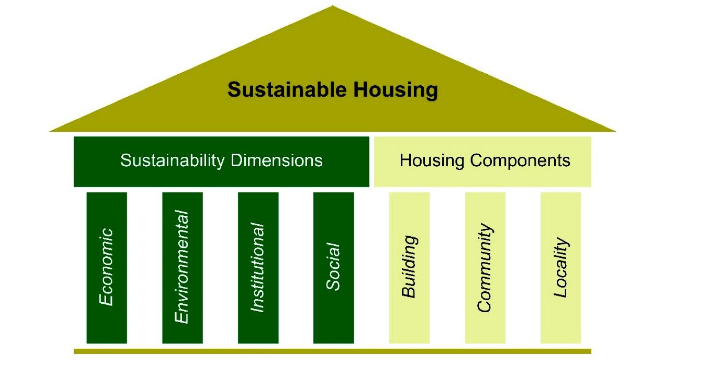
Modern Technologies in the Housing Sector
- PMAY Mission and Light House Projects
- Light House Projects (LHPs) under PMAY use modern technologies like Mivan construction and Insulating Concrete Formwork for faster, resilient, and affordable housing.
- Global Housing Technology Challenge-India (GHTC-India) aims to incorporate sustainable and disaster-resilient global housing technologies.
- Mivan Construction Technology
- Utilizes advanced aluminium formwork for faster and eco-friendly construction, surpassing traditional methods.
- Recyclable and reusable, it reduces environmental impact and construction wastage.
- Insulating Concrete Formwork (ICF) Technique
- Uses double-walled polystyrene panels filled with concrete for strong, durable structures.
- Provides excellent insulation for heat and sound, maintaining steady thermal mass energy.
- Hybrid Concrete Construction
- Combines cast-in-place concrete with precast materials for accelerated construction, cost-effectiveness, and quality control.
Sustainability Concerns in Housing Development
- Issues Due to Construction Technologies
- Thermal Distress: Inadequate insulation leading to increased heat gain.
- Elevated GHG Emissions: Insufficient insulation causing higher electricity consumption.
- Increased Electricity Consumption: Use of lower efficiency appliances contributing to greenhouse gas emissions.
- Challenges in Housing Projects
- Locational Factors: Lack of master plans in census towns affecting housing projects.
- Inadequacies in Building Typology: Dense, high-rise developments impacting sustainability.
- Excessive Reliance on Centralized Systems: Overburdened infrastructure lacking sustainability provisions.
- Inefficient Beneficiary-Led Construction
- Approximately 63% of PMAY-U projects self-constructed by beneficiaries.
- Lack of adherence to building norms and safety codes, requiring improved sustainability integration.
- Lack of Awareness and Multi-Stakeholder Nature
- Implementing passive designs faces challenges due to complex stakeholder involvement.
- End-users' lack of awareness hinders adoption, emphasizing the need for increased collaboration.
Steps for a Sustainable Housing Sector
- Prioritizing Thermal Comfort
- Integrating passive design strategies for thermal comfort in vulnerable communities.
- Reinforcing building codes like Eco Niwas Samhita for improved indoor thermal comfort.
- Raising Awareness About Passive Designs
- Encouraging ecosystem change for adoption of passive designs.
- Incentivizing developers to prioritize and implement passive design codes.
- Promoting Green Buildings
- Enhancing policies to increase 'Green Buildings' share in the market.
- Potential reduction of national power demand by 25% in 2030 through improved energy efficiency.
- Initiating Location-Tailored Projects
- Conducting socio-economic surveys for understanding livelihood patterns.
- Zoning-based inclusion for affordable housing in strategically suitable locations.
- Robust Layout and Building Design
- Enforcing efficiency criteria for envelope design and shading devices.
- Implementing guidelines like Eco Niwas Samhita for a sustainable envelope design.
Conclusion
- The interim Budget 2024's focus on housing is crucial for 'Housing for All.'
- Balancing trade-offs between quality of life, environment, and sustainable practices is imperative.
- Collaborative efforts and incentivization are needed for a shift towards sustainable housing.
- An environmental-conscious approach will create resilient structures and models of sustainability for an inclusive future.
|
UPSC Previous Year Questions Mains (2016) Q. With a brief background of quality of urban life in India, introduce the objectives and strategy of the ‘Smart City Programme.” Mains (2013) Q. Discuss the various social problems which originated out of the speedy process of urbanization in India. |
Source: TH
MAHA LAND BANK SYSTEM - Case Study of the Day
The Aspirational District of Washim in Maharashtra has established a unique online repository called the Land Bank Portal, offering information on government land allocation for various purposes such as affordable housing, irrigation, industries, and more, aiming to bridge information gaps and serve citizen needs.
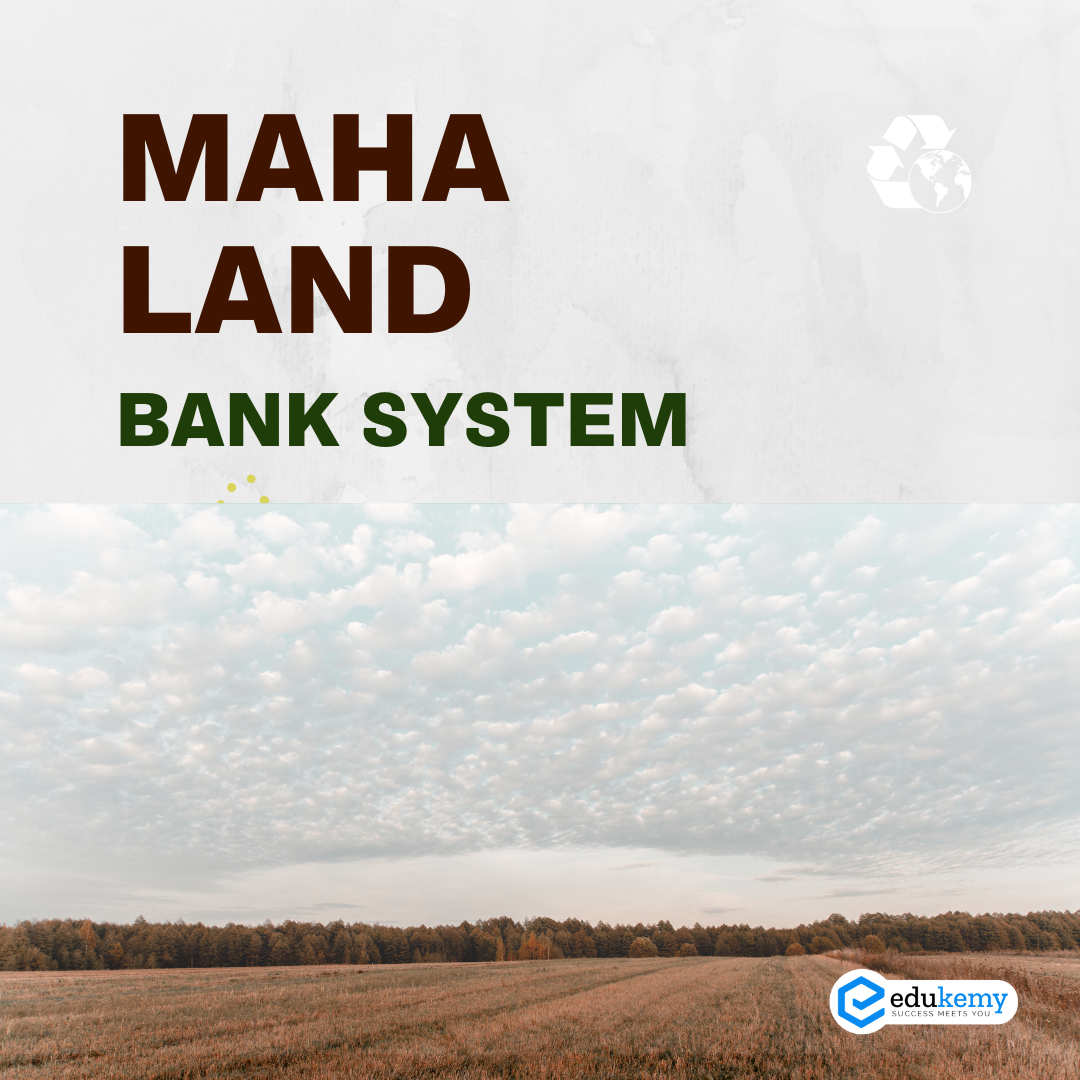
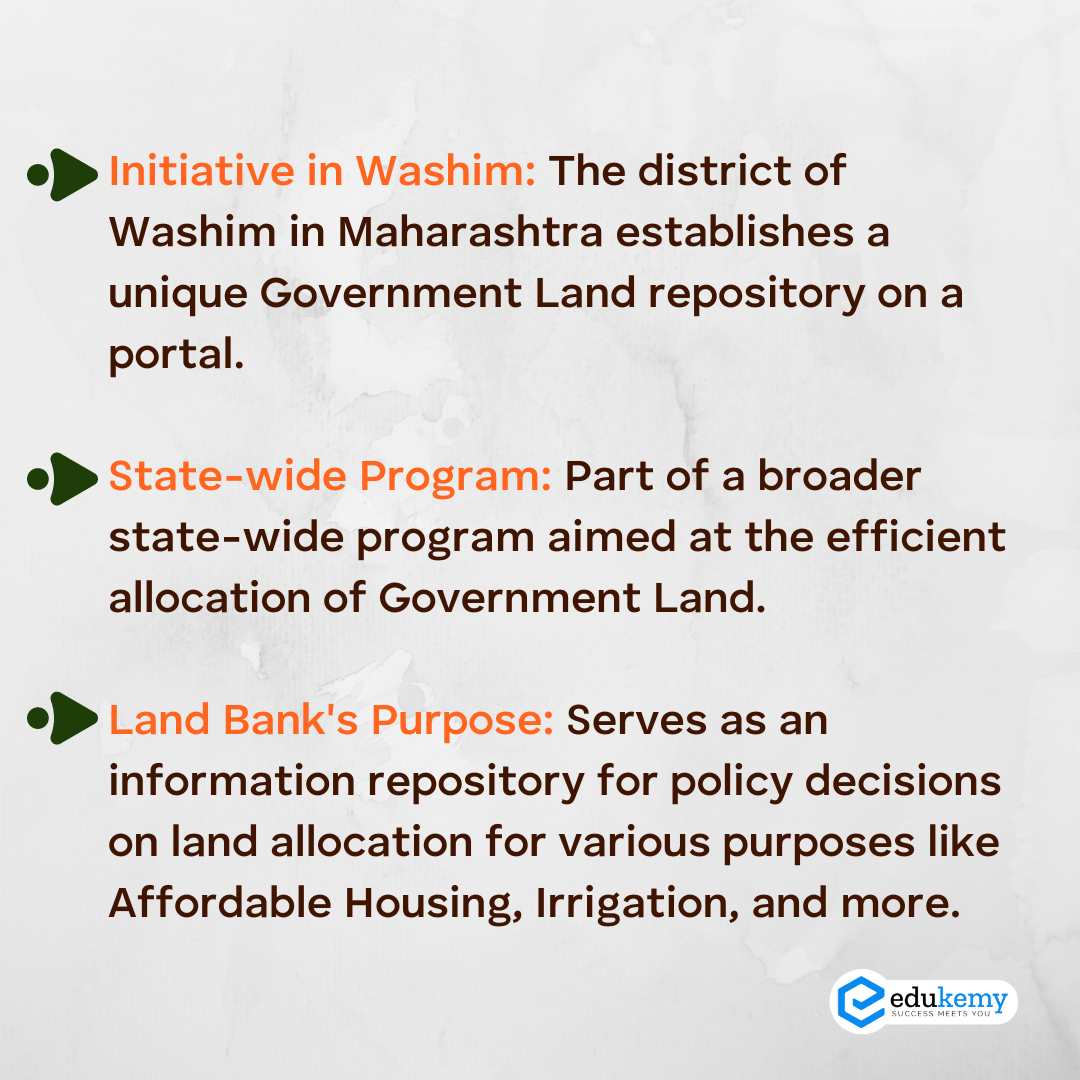
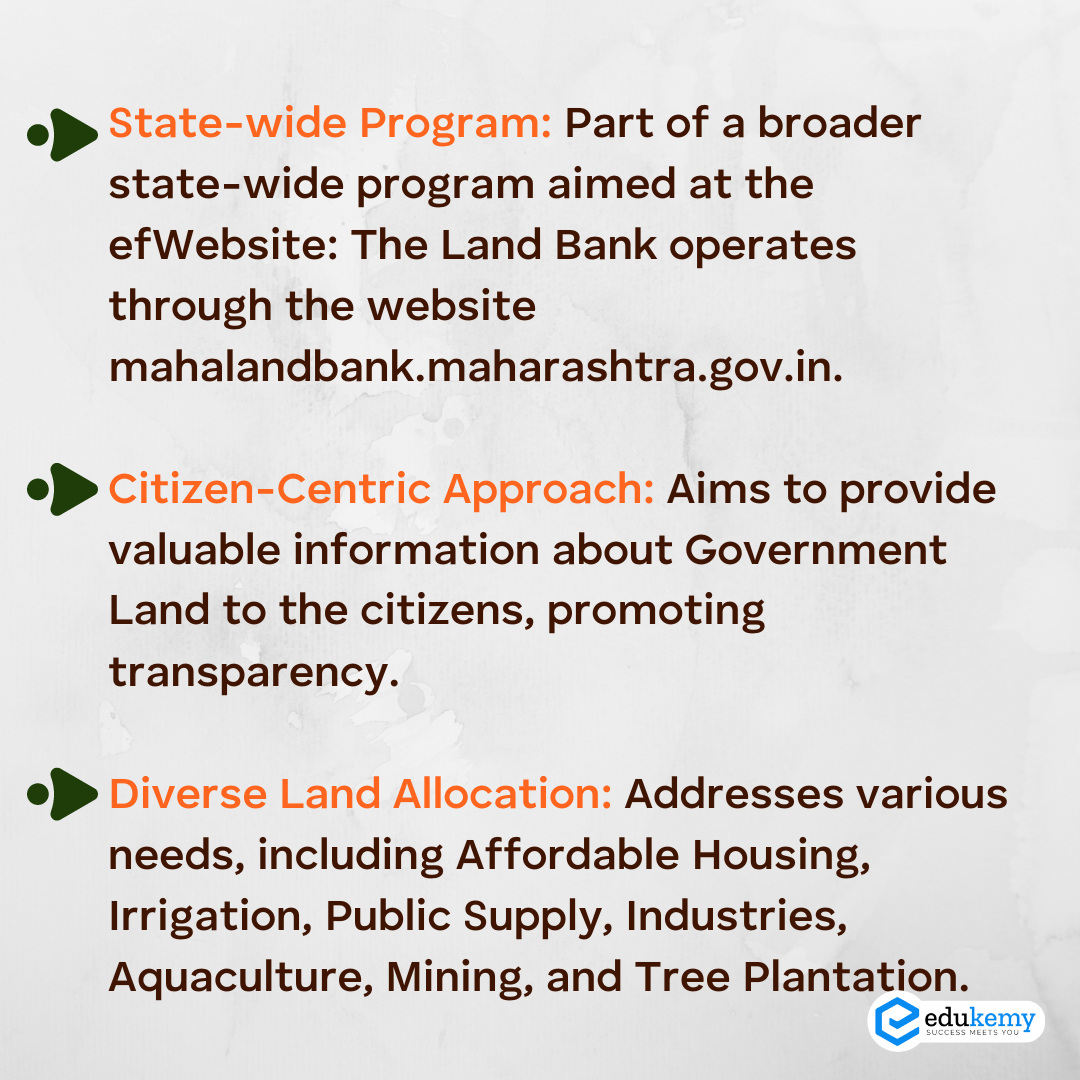
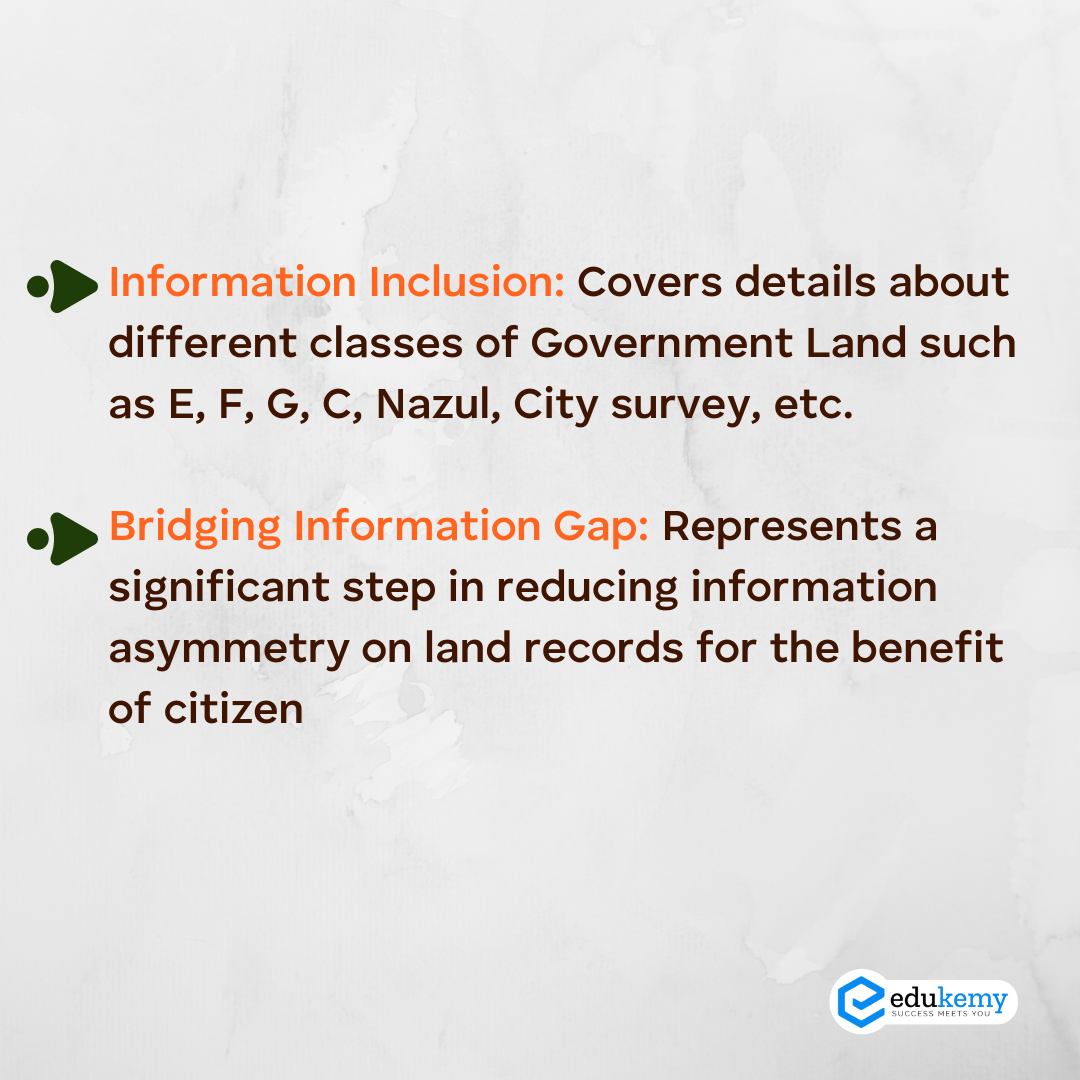
Share the article
Edukemy’s Current Affairs Quiz is published with multiple choice questions for UPSC exams
MCQ
Get Latest Updates on Offers, Event dates, and free Mentorship sessions.

Get in touch with our Expert Academic Counsellors 👋
FAQs
UPSC Daily Current Affairs focuses on learning current events on a daily basis. An aspirant needs to study regular and updated information about current events, news, and relevant topics that are important for UPSC aspirants. It covers national and international affairs, government policies, socio-economic issues, science and technology advancements, and more.
UPSC Daily Current Affairs provides aspirants with a concise and comprehensive overview of the latest happenings and developments across various fields. It helps aspirants stay updated with current affairs and provides them with valuable insights and analysis, which are essential for answering questions in the UPSC examinations. It enhances their knowledge, analytical skills, and ability to connect current affairs with the UPSC syllabus.
UPSC Daily Current Affairs covers a wide range of topics, including politics, economics, science and technology, environment, social issues, governance, international relations, and more. It offers news summaries, in-depth analyses, editorials, opinion pieces, and relevant study materials. It also provides practice questions and quizzes to help aspirants test their understanding of current affairs.
Edukemy's UPSC Daily Current Affairs can be accessed through:
- UPSC Daily Current Affairs can be accessed through Current Affairs tab at the top of the Main Page of Edukemy.
- Edukemy Mobile app: The Daily Current Affairs can also be access through Edukemy Mobile App.
- Social media: Follow Edukemy’s official social media accounts or pages that provide UPSC Daily Current Affairs updates, including Facebook, Twitter, or Telegram channels.



